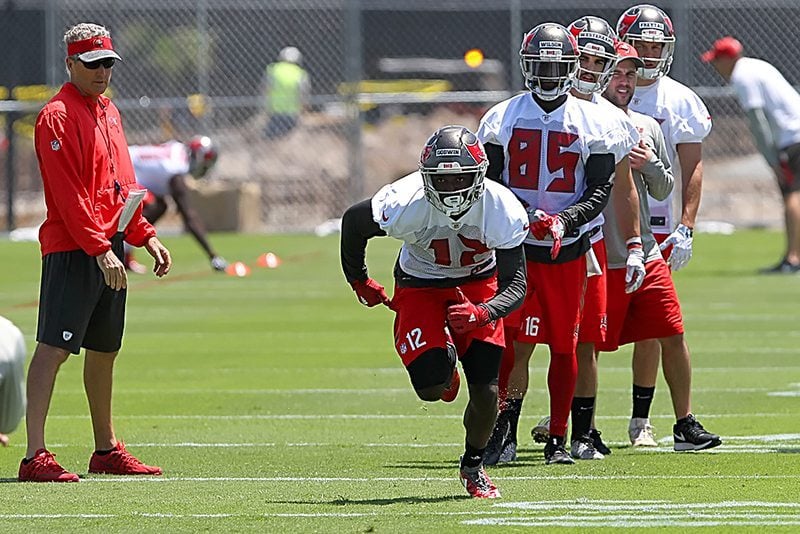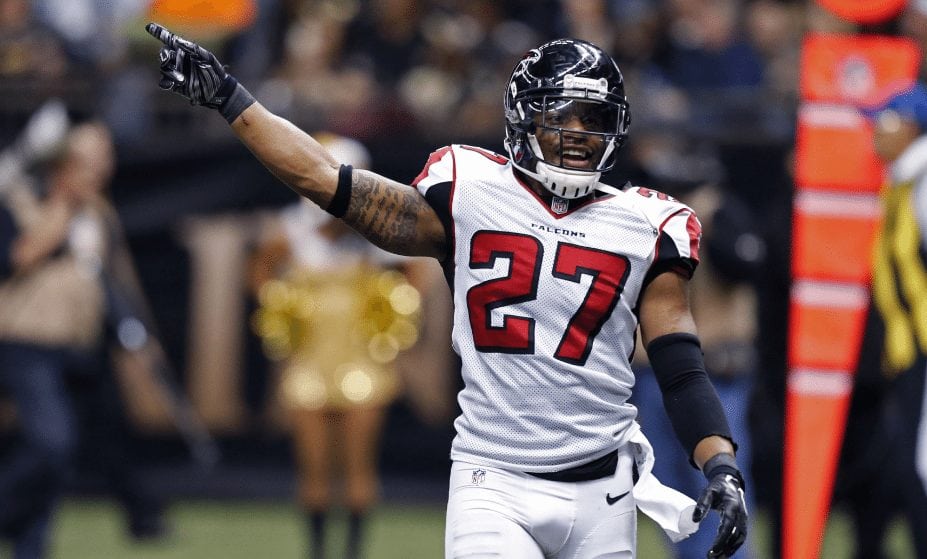Cover 3 is a weekly feature column written by PewterReport.com’s Tampa Bay Buccaneers beat writer Trevor Sikkema published every Tuesday. The column, as its name suggests, comes in three phases: a statistical observation, an in-depth film breakdown, and a “this or that” segment where the writer asks the reader to chose between two options.
SIKKEMA’S STAT OF THE WEEK
“It’s difficult to make predictions, especially about the future.”
That is a sentence that Rotoworld’s NFL Draft analyst, Josh Norris, has in his Twitter bio. It’s a simple saying, and yet, I think we forget it all too often in this ever-growing draft culture that has seemed to explode in popularity over the last five or so years on the Internet.
With more interest in the NFL Draft, naturally, more smart people have joined the conversations. Each year we see new examples of ways to do just what that first sentences states is difficult to do: “predict the future.”
Past Cover 3 columns have featured a few of those outside-the-box approaches. In the first Cover 3 I wrote for PewterReport.com, we took a look at wide receiver market share, a formula created by Bill Jones to try to quantify what wide receiver production really means in college, and how there’s more to just saying “Player X caught this many passes during his career.” We took this formula and brought it to the NFL using Mike Evans’ first three season as the examples. In it, we were able to identify when he was being used most efficiently.
In a later Cover 3, we featured the work of Justis Mosqueda, creator of the Force Players formula. This formula was one of the first of its kind to really diagnose what Combine numbers meant for pass rushers, and how certain thresholds do exist in the NFL where, if there is a part of a player’s athleticism scores that fall short, it drastically hinders their chance at success in the NFL. In that Cover 3, we put Missouri defensive end, Charles Harris, into the film room to see if he would pass such a test – this was before the Combine.
Today, I’m bringing in another new project to show to you all (if you haven’t seen it already, which, chances are you have). The formula for this Cover 3 is called Reception Perception, an in-depth, very detailed film chart created by NFL.com’s Matt Harmon. This project turns prospect tape into math and success rates using a wide receiver route tree. In it, Harmon watches multiple games of a college prospect, charts every single route they run, whether they get the ball or not, and determines how much success a receiver has on any given rep with separation, precision and overall athletic ability. Those numbers are then put into a route tree chart and player traits begin to take shape through percentages.
If you’ve never seen a wide receiver route tree before, this is what it looks like.
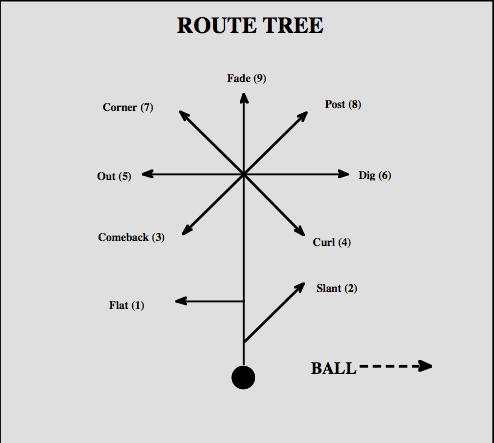
These are essentially the nine routes a receiver can run on any given play (screen passes and anything that is a double move aren’t on the route tree since those are combination routes). The chart also identifies the names of each of the routes. So, take a look, bookmark this page, come back to it and read it, and when you talk to your friends during the games this season you can sound super smart – or you can better yet at the play-by-play guys on TV.
Anyways.
When putting a prospect’s tape under the Reception Perception project, you’ll notice which routes a wide receiver runs best, therefore establishing “where they win” as a receiver. This helps identify traits and overall projection to the next level. The more dominant or diverse a receiver is in the Reception Perception project, the easier it is to see what they can do at the next level – remember, in the NFL draft, it’s often strengths that get stronger, not weaknesses that disappear as prospects go from college to the NFL.
The reason I chose to feature Harmon’s work in this week’s Cover 3 (it was only a matter of time) is because one of his project’s favorite wide receivers from the 2017 draft class was none other than the Tampa Bay Buccaneers’ third round pick, Penn State’s Chris Godwin. In fact, after Godwin’s part of the project was finished, Harmon labeled him, “The most underrated WR in the 2017 NFL Draft.”
Let’s get into some of the numbers and see why.
According to Harmon, in Godwin’s six-game Reception Perception sample from 2017, he took 56 percent of his reps at left wide receiver and 44 percent at outside right – Godwin was never lined up in the slot during any play of those six games. Harmon notes that one aspect of his formula that has evolved over the years is putting more weight into wide receivers who only play on one side of the field. He uses Dorial Green-Beckham and Kevin White as his examples. Harmon was high on both of these players when they were coming into the league due to their exceptional Reception Perception results, but both have not panned out to their Reception Perception success. He thinks that exclusively playing one side of the field could be a big factor why. So, Godwin playing an even amount on both sides was a good start.
Though Godwin’s numbers from 2015 to 2016 were down on the stats sheet, his efficiency was not. Godwin only saw targets on 25.9 percent of the routes he ran during the six-game sample, but converted on almost 70 percent of the passes thrown his way, which was much lower than normal on the usage end, and much higher on the efficiency end.
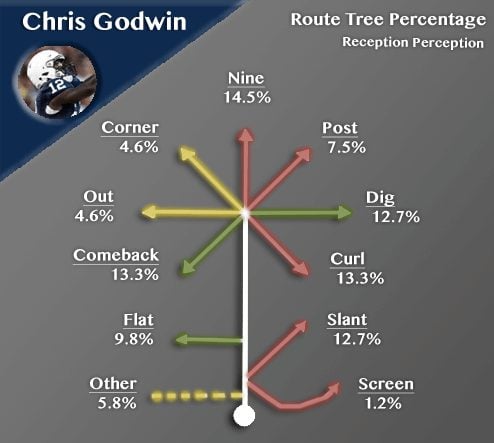
The chart shown above is Godwin’s usage chart, not his success chart. This chart shows which routes he ran out of 100 percent of the time. The red simply means that it’s below the average percent of routes run from a two-year starters, the yellow is right around the average, and the green means this prospect ran a greater percentage of this route than other wide receivers.
This is where Godwin’s Reception Perception sample starts to get interesting – in a good way for Bucs fans.
Most receiver prospects have their highest route percentages on slants, curls, posts and nine routes. But, if you’ll see, those were the four routes that Godwin ran at a below average rate (again, not in efficiency, in volume). Godwin’s go-to routes were actually the dig (12.7 percent), comeback (13.3 percent) and flat (9.8 percent). What’s good about that, is that the dig and comeback routes are two patterns in the route tree that require most detail and technical precision to run, not only effectively, but naturally as we see Godwin do. Godwin’s usage chat alone speaks to how crisp he is as a route runner, because, if he wasn’t, the team wouldn’t ask him to run such routes – remember, he did this on both side of the field while means he’s fluid and precise moving in any direction.
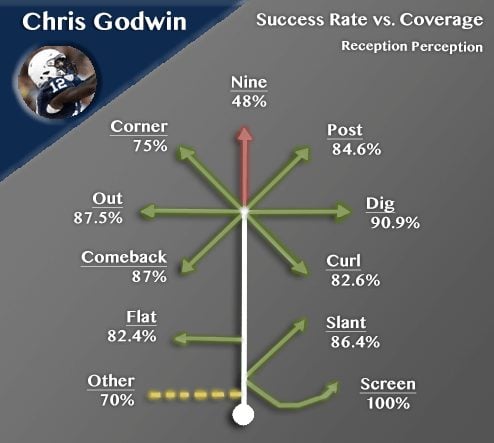
Now we take a look at Godwin’s success chart, and oh boy is it a beauty.
We’ve heard Buccaneers head coach Dirk Koetter say before that Godwin actually tested better athletically with straight line speed at the Combine than they thought he would (they were already high on him before then). That makes sense when you see that the only route he didn’t run with an above average score on was the nine route. However, knowing that he has the speed to separate (ran a 4.42) on some occasions only makes this route tree look even better. It’s as if success on nine routes is just a teachable thing for him to break coverage and get to that straight line speed we know he has – you can teach the technique, not the speed.
It’s ironic because most of the time, it’s the straight line speed that prospects are obsessed with and choose to make their bread and butter. Godwin has it, but he choose uses his athleticism in different ways. His 86.4 percent success rate on slant routes and 84.6 percent success rate on post routes show he has the ability to not only veer direction quickly, but keep his speed. Then, taking that a step further, his 90.9 percent success rate on dig routes and 87.5 percent success rate on out routes show he can change direction at a 45 degree angle and still create separation. Finally, the 87 percent and 82.6 percent success rates on comeback and curl routes prove he can completely turn his body around faster than a cornerback can read and react. Each of those three phases of the route tree require more changeling athletic explosiveness and body control. Godwin has it in all three phases, and that’s what separation and “where he wins” comes from.
In some parting notes, Harmon wrote that, though Clemson’s Mike Williams was known as the top “go up and get it” man in the class, Godwin recorded an 85.7 percent contested catch conversion rate, which was the highest percentage among prospects charted the last two years (even more than Williams). Harmon goes on to explain that Godwin is one of the best in the class as playing and catching through traffic, and has good football instincts to get the ball at its highest point.

Bucs WR Chris Godwin – Photo by: Getty Images
Godwin posted a 73.5 percent success rate vs. coverage in the six-game sample, which was the fourth-highest score in the 2017 NFL Draft class and falls at the 76th percentile among prospects he charted over the last two years. Godwin also posted an 85.5 success rate vs. zone coverage, which was again the fourth-highest among prospects in the 2017 NFL Draft. Plus, Godwin’s 68.8 percent success rate vs. double coverage was above the 80th percentile.
With the numbers and the charts, it’s easy to see why Harmon marked Godwin as one of “his guys.” Harmon pegged Godwin as a player who deserved to go in the early Day 2 second round, so Tampa Bay getting him all the way at pick No. 84 in the third round had to be one of draft weekend’s biggest steals for him.
Knowing the stats and the success rates, let’s look at the film ourselves and watch those numbers come alive as we take Godwin into the film room on the next page.

